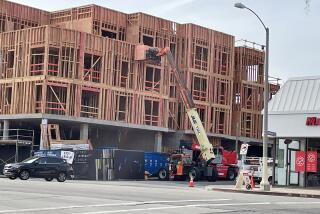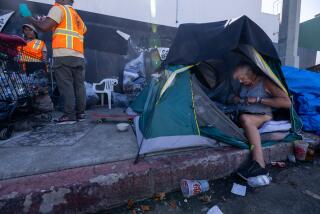Aid for Displaced Slum Residents Urged
- Share via
THOUSAND OAKS — Seeking greater compassion in slum crackdowns, social activists met with city officials Wednesday to discuss last month’s sweep of a rundown immigrant village that left some people homeless and forced others into similar ghettos.
Community leaders came out of the two-hour session at City Hall promising that the next time the city finds an overcrowded slum, charities will be alerted long before anyone is ordered to move. They plan a series of meetings that will result in a city policy allowing charities and officials to conduct slum sweeps together, while also giving leaders of the Latino community a bigger role in housing issues.
Activists have criticized the early morning shantytown crackdown, saying that building inspectors frightened impoverished workers already struggling to get by in this affluent suburb.
Many of the 50 workers who lived in the huts have moved into rundown, overcrowded houses in other parts of Thousand Oaks.
In response to the ghetto’s discovery, the City Council has authorized the creation of an anti-slumlord ordinance that would punish property owners with fines and court action.
Wednesday’s meeting--attended by more than two dozen activists, city officials and members of county organizations--was called to discuss how the city can help those forced out of slums find better homes.
“In a sense, today was a historic meeting,” said Otto Stoll, co-chairman of the affordable housing group Many Mansions. “I think it’s the first time we’ve had everyone dealing with housing in our community in one room at one time.”
Olav Hassel, the city’s housing services director, said the extreme conditions at the downtown slum made activists and city officials realize they should work together.
“There will be homes in the future that we’ll be looking at,” Hassel said. “We’ll assemble a team.”
The focus of the meeting was a Many Mansions proposal that included a number of suggestions for future slum actions, including earmarking city, county and federal funds for use in slum crackdowns. Such money would help displaced people pay for moving expenses and security deposits at new apartments.
The proposal also recommends that the city create housing vouchers to help the displaced rent new apartments. That approach would emulate a strategy Ventura officials took to assist inhabitants of a shantytown on the Ventura River bottom after flooding two years ago.
“It’s humiliating to live [in a slum] and have someone tell you to leave,” said Dan Hardy, the director of Many Mansions. “This is to help them with the disorientation and humiliation.”
Many Mansions also suggested inviting the city’s fledgling Latino advocacy group, the Hispanic Organization for Personal Excellence (HOPE), to serve as an intermediary between the city and residents of areas targeted in building investigations. Members of HOPE may canvass neighborhoods, informing residents of charities that can provide shelter and financial assistance.
Another proposal would have members of the Latino advocacy group use a Thousand Oaks Police Department van to go from neighborhood to neighborhood, in order to build a sense of trust between immigrants and authorities. Miguel Osornio, HOPE’s president, said it would make sense for the group to play that role because its members speak Spanish and have knowledge of the city’s Latino community.
“Sometimes these people are afraid of the authorities,” Osornio said. “We need a solution.”
Stoll said improved communication with the Latino community is an urgent issue for Thousand Oaks.
“Whether we like it or not, most of the people affected by [slum conditions] are Hispanic and most [city leaders] are white,” he said. “We need a bridge.”
Officials acknowledged that they face thorny issues, including figuring out how to help undocumented immigrants. Many living in the shantytown admitted being in the country illegally.
Some who attended Wednesday’s meeting said that charities, not the city, must lead the way in helping displaced workers, because charities do not face as many financial restrictions. Housing advocates argued that the only long-term solution to slums is to build more affordable housing.
To bolster that argument, they handed out statistics intended to underscore the plight of low-income renters in Thousand Oaks. Those statistics showed that the average family waiting for one of Many Mansion’s subsidized apartments makes $1,151 a month--just a few hundred dollars more than rent for an average one-bedroom apartment in the city.
Those realities fuel overcrowding and substandard conditions, said Hassel, the city housing director.
“The only thing that’s wrong with poor people is they don’t have any money,” he said. “People don’t want to live in slums . . . It’s not their choice.”
More to Read
Sign up for Essential California
The most important California stories and recommendations in your inbox every morning.
You may occasionally receive promotional content from the Los Angeles Times.










